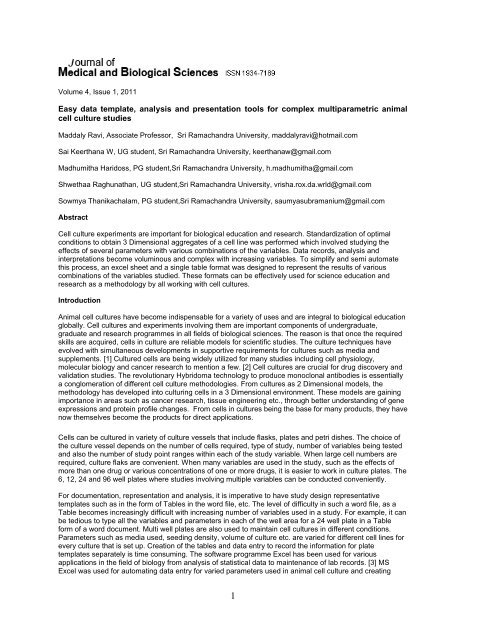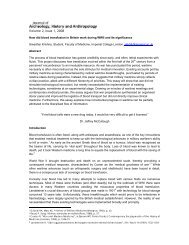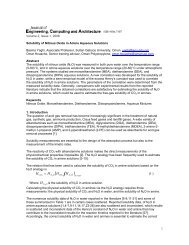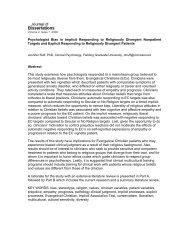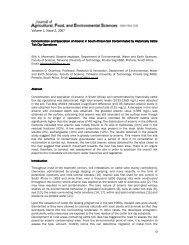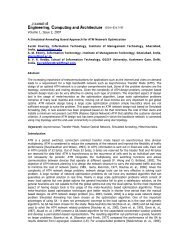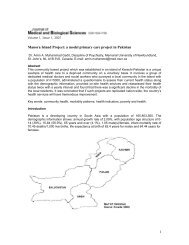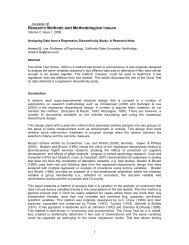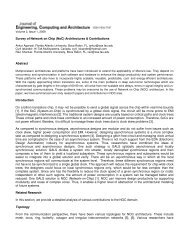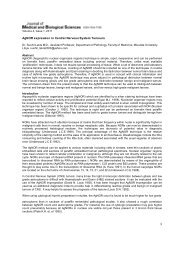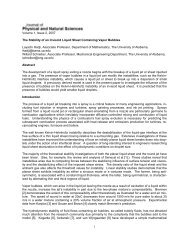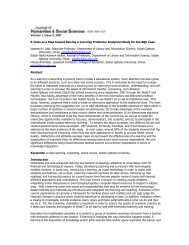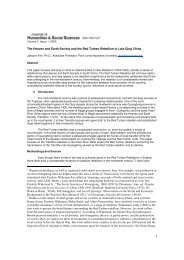Easy data template, analysis and presentation tools for complex ...
Easy data template, analysis and presentation tools for complex ...
Easy data template, analysis and presentation tools for complex ...
You also want an ePaper? Increase the reach of your titles
YUMPU automatically turns print PDFs into web optimized ePapers that Google loves.
Volume 4, Issue 1, 2011<br />
<strong>Easy</strong> <strong>data</strong> <strong>template</strong>, <strong>analysis</strong> <strong>and</strong> <strong>presentation</strong> <strong>tools</strong> <strong>for</strong> <strong>complex</strong> multiparametric animal<br />
cell culture studies<br />
Maddaly Ravi, Associate Professor, Sri Ramach<strong>and</strong>ra University, maddalyravi@hotmail.com<br />
Sai Keerthana W, UG student, Sri Ramach<strong>and</strong>ra University, keerthanaw@gmail.com<br />
Madhumitha Haridoss, PG student,Sri Ramach<strong>and</strong>ra University, h.madhumitha@gmail.com<br />
Shwethaa Raghunathan, UG student,Sri Ramach<strong>and</strong>ra University, vrisha.rox.da.wrld@gmail.com<br />
Sowmya Thanikachalam, PG student,Sri Ramach<strong>and</strong>ra University, saumyasubramanium@gmail.com<br />
Abstract<br />
Cell culture experiments are important <strong>for</strong> biological education <strong>and</strong> research. St<strong>and</strong>ardization of optimal<br />
conditions to obtain 3 Dimensional aggregates of a cell line was per<strong>for</strong>med which involved studying the<br />
effects of several parameters with various combinations of the variables. Data records, <strong>analysis</strong> <strong>and</strong><br />
interpretations become voluminous <strong>and</strong> <strong>complex</strong> with increasing variables. To simplify <strong>and</strong> semi automate<br />
this process, an excel sheet <strong>and</strong> a single table <strong>for</strong>mat was designed to represent the results of various<br />
combinations of the variables studied. These <strong>for</strong>mats can be effectively used <strong>for</strong> science education <strong>and</strong><br />
research as a methodology by all working with cell cultures.<br />
Introduction<br />
Animal cell cultures have become indispensable <strong>for</strong> a variety of uses <strong>and</strong> are integral to biological education<br />
globally. Cell cultures <strong>and</strong> experiments involving them are important components of undergraduate,<br />
graduate <strong>and</strong> research programmes in all fields of biological sciences. The reason is that once the required<br />
skills are acquired, cells in culture are reliable models <strong>for</strong> scientific studies. The culture techniques have<br />
evolved with simultaneous developments in supportive requirements <strong>for</strong> cultures such as media <strong>and</strong><br />
supplements. [1] Cultured cells are being widely utilized <strong>for</strong> many studies including cell physiology,<br />
molecular biology <strong>and</strong> cancer research to mention a few. [2] Cell cultures are crucial <strong>for</strong> drug discovery <strong>and</strong><br />
validation studies. The revolutionary Hybridoma technology to produce monoclonal antibodies is essentially<br />
a conglomeration of different cell culture methodologies. From cultures as 2 Dimensional models, the<br />
methodology has developed into culturing cells in a 3 Dimensional environment. These models are gaining<br />
importance in areas such as cancer research, tissue engineering etc., through better underst<strong>and</strong>ing of gene<br />
expressions <strong>and</strong> protein profile changes. From cells in cultures being the base <strong>for</strong> many products, they have<br />
now themselves become the products <strong>for</strong> direct applications.<br />
Cells can be cultured in variety of culture vessels that include flasks, plates <strong>and</strong> petri dishes. The choice of<br />
the culture vessel depends on the number of cells required, type of study, number of variables being tested<br />
<strong>and</strong> also the number of study point ranges within each of the study variable. When large cell numbers are<br />
required, culture flaks are convenient. When many variables are used in the study, such as the effects of<br />
more than one drug or various concentrations of one or more drugs, it is easier to work in culture plates. The<br />
6, 12, 24 <strong>and</strong> 96 well plates where studies involving multiple variables can be conducted conveniently.<br />
For documentation, re<strong>presentation</strong> <strong>and</strong> <strong>analysis</strong>, it is imperative to have study design representative<br />
<strong>template</strong>s such as in the <strong>for</strong>m of Tables in the word file, etc. The level of difficulty in such a word file, as a<br />
Table becomes increasingly difficult with increasing number of variables used in a study. For example, it can<br />
be tedious to type all the variables <strong>and</strong> parameters in each of the well area <strong>for</strong> a 24 well plate in a Table<br />
<strong>for</strong>m of a word document. Multi well plates are also used to maintain cell cultures in different conditions.<br />
Parameters such as media used, seeding density, volume of culture etc. are varied <strong>for</strong> different cell lines <strong>for</strong><br />
every culture that is set up. Creation of the tables <strong>and</strong> <strong>data</strong> entry to record the in<strong>for</strong>mation <strong>for</strong> plate<br />
<strong>template</strong>s separately is time consuming. The software programme Excel has been used <strong>for</strong> various<br />
applications in the field of biology from <strong>analysis</strong> of statistical <strong>data</strong> to maintenance of lab records. [3] MS<br />
Excel was used <strong>for</strong> automating <strong>data</strong> entry <strong>for</strong> varied parameters used in animal cell culture <strong>and</strong> creating<br />
1
<strong>template</strong>s <strong>for</strong> 6-well, 12-well <strong>and</strong> 24-well cell culture plates. To automate <strong>and</strong> facilitate multi parametric<br />
<strong>analysis</strong> of <strong>data</strong>, a tool to tabulate diverse components involved in cell culture on a single plat<strong>for</strong>m was<br />
adopted as previously described. [4] The <strong>data</strong> was entered into an excel file to create a plate <strong>template</strong>.<br />
Programming the cells on the plate <strong>template</strong> was made such that the <strong>data</strong> entered in previously is<br />
automatically displayed in the plate <strong>template</strong>. Likewise, once the results are obtained, the need to represent<br />
the net result of a <strong>complex</strong> study in a single <strong>for</strong>mat is very useful <strong>for</strong> several reasons including significant<br />
reduction in the numbers of entities such as Tables/Graphs, etc <strong>and</strong> also <strong>for</strong> easier comparisons of the<br />
multiple variables. A single table where different parameters can be analyzed <strong>and</strong> represented was<br />
developed towards this. These innovative <strong>tools</strong> have applications <strong>for</strong> easy <strong>data</strong> <strong>presentation</strong>, <strong>analysis</strong> <strong>and</strong><br />
interpretation <strong>and</strong> also as important components of teaching, learning <strong>and</strong> research at the undergraduate<br />
<strong>and</strong> graduate level practical sessions involving cell cultures.<br />
Methodology<br />
Cell culture plate layout designs with experimental multiparametric details as an excel file<br />
The parameters studied<br />
The parameters considered <strong>for</strong> the study include well identification number, volume of medium added <strong>for</strong><br />
plating, concentration of agarose in the medium, the medium in which agarose was dissolved, presence or<br />
absence of conditioned medium <strong>and</strong> the cell seeding density.<br />
Data entry<br />
An excel sheet was opened <strong>and</strong> different columns were named according to the different parameters<br />
involved in various wells of a cell culture plate as represented in Figures 1 <strong>and</strong> 2.<br />
Creation of a <strong>template</strong><br />
A <strong>template</strong> <strong>for</strong> 6 well, 12 well <strong>and</strong> 24 well plate was created using “merge <strong>and</strong> centre” <strong>for</strong> the selected cells.<br />
The border <strong>for</strong> the <strong>template</strong> was given in the following series of steps:<br />
The entire <strong>template</strong> was selected<br />
The selected <strong>template</strong> was left clicked on<br />
“Format Cells” was selected<br />
The tab “Border” in the dialogue box was chosen<br />
The options “Outline” <strong>and</strong> “Inside” <strong>and</strong> click on “OK” were selected<br />
2
Figure 1. Data entry into excel cells <strong>for</strong> the fields well identity, agarose volume, % agarose composition,<br />
medium used <strong>for</strong> dissolving agarose, presence or absence of conditioned medium <strong>and</strong> seeding densities.<br />
Programming the excel sheet cells<br />
The cells corresponding to the culture plate wells were programmed to input <strong>data</strong> from the excel sheet using<br />
‘CONCATENATE’ function to merge <strong>data</strong> from the previously entered in<strong>for</strong>mation at the top of the excel<br />
sheet. The programming was done by the following series of steps <strong>and</strong> represented in Figure 3.<br />
The cells to be programmed were selected<br />
<br />
<br />
The <strong>for</strong>mula tab was clicked <strong>and</strong> concatenate <strong>for</strong>mula was selected.<br />
It is a text function used to join several text strings into one text string <strong>and</strong> parenthesis is used to enter<br />
the <strong>for</strong>mula <strong>for</strong> programming the cell. The <strong>for</strong>mula starts with a double quotes <strong>and</strong> ends with a double<br />
quote:<br />
=CONCATENATE("",D2," of ",E2," % Agarose in ",F2," with a SD of ", H5," M (CM",G2,")")<br />
Figure 2. The <strong>template</strong> has been created using ‘Merge <strong>and</strong> Centre’ Function <strong>and</strong> choosing<br />
‘Wrap Text’ option <strong>and</strong> the borders are framed using ‘Format Cells’<br />
3
Figure 3. Programming of the Cells using ‘CONCATENATE’ function to merge many text strings from different<br />
cells into single output cell.<br />
Conditional Formatting of the cells<br />
Conditional Formatting offers <strong>and</strong> easy way to apply <strong>for</strong>mats that stay dormant until the values in the highlighted<br />
cells achieve a specified state as given in Figure 4. Here a tool was used to highlight cells with a certain color<br />
depending on cell value. The series of steps are as follows:<br />
<br />
<br />
<br />
<br />
<br />
The cells to be highlighted depending upon the condition were selected<br />
The option “Conditional Formatting” <strong>and</strong> select “New Rule” was clicked on<br />
The second option “Format only cells that contain” was selected <strong>and</strong> “specific text” in the dropdown box<br />
under “Edit the rule description” was subsequently selected <strong>and</strong> the value was entered.<br />
“Format” was clicked <strong>and</strong> different options such as number, font, border, fill etc., were used<br />
“Ok” was clicked to allow conditional <strong>for</strong>matting.<br />
On conditional <strong>for</strong>matting, different parameters are represented in different ways such as:<br />
<br />
<br />
The different cells containing PBS <strong>and</strong> RPMI are shown in different shades<br />
Cells with conditioned medium are shown by double underlining<br />
4
Figure 4. Conditional Formatting of the programmed cells was used to change parameters in the <strong>for</strong>mat of the<br />
<strong>template</strong> to distinguish between different conditions in the cell culture plate<br />
Re<strong>presentation</strong> of analysed <strong>data</strong><br />
In studies that involve series of experiments to st<strong>and</strong>ardize the 3D cell culture conditions, various variables<br />
<strong>and</strong> combinations of the variables have to be observed, <strong>data</strong> recorded <strong>and</strong> analyzed. For this purpose, a<br />
single <strong>template</strong> to analyze <strong>and</strong> represent all the parameters to record the results was developed. The<br />
parameters include concentration of agarose, culture surface area, types of culture medium, culture medium<br />
volumes, presence or absence of conditioned medium <strong>and</strong> various seeding densities. Thus the result<br />
entered in a single box is a representative of a combination of all these parameters as shown in Table 1.<br />
CONCENTRATION OF AGAROSE<br />
CM 0.25% 0.5% 0.75%<br />
+/- 6 12 24 6 12 24 6 12 24<br />
PBS<br />
+ 1<br />
ml<br />
-<br />
+ 750<br />
µl<br />
-<br />
+ 500<br />
µl<br />
-<br />
+ 250<br />
µl<br />
-<br />
V<br />
O<br />
L<br />
U<br />
M<br />
E<br />
+ 1<br />
ml<br />
-<br />
RPMI<br />
+ 750<br />
µl<br />
-<br />
+ 500<br />
µl<br />
-<br />
+ 250<br />
µl<br />
-<br />
+/- X Y X Y X Y X Y X Y X Y X Y X Y X Y<br />
SEEDING DENSITIES<br />
Table 1. The <strong>template</strong> provides <strong>for</strong> various parameters including concentration of agarose, medium of cell<br />
suspension, volume of medium added, presence or absence of conditioned medium (CM) <strong>and</strong> seeding<br />
densities per well in a 6 well, 12 well & 24 well plate.<br />
5
Results<br />
An excel file was developed in a series of steps with simple <strong>for</strong>mulae to make <strong>data</strong> entry <strong>and</strong> record keeping<br />
simpler <strong>for</strong> multiparametric cell culture studies. Also, a single table <strong>for</strong>mat was developed which can serve<br />
as a <strong>template</strong> <strong>for</strong> simultaneous <strong>data</strong> entry, result re<strong>presentation</strong> <strong>and</strong> <strong>analysis</strong> of multiple parameters involved<br />
in cell culture studies.<br />
Discussion<br />
Cell cultures offer with excellent in vitro experimental models <strong>and</strong> should be well st<strong>and</strong>ardized <strong>for</strong> useful<br />
study results. [5] St<strong>and</strong>ardization of the optimal cell types <strong>and</strong> the culture types/conditions require multiple<br />
experimental variables. Data <strong>analysis</strong> <strong>and</strong> interpretation is the most important <strong>and</strong> critical part of education<br />
<strong>and</strong> research. The raw <strong>data</strong> obtained from experiments should be presented in an organized manner so that<br />
useful in<strong>for</strong>mation can be extracted from it. The excel <strong>template</strong> we describe here serves the required<br />
purpose of easy <strong>data</strong> entry along with maximum in<strong>for</strong>mation as obtained in the final <strong>template</strong>. Also, the<br />
results obtained from all the variables/combinations of the variables could be entered into the single table<br />
<strong>for</strong>mat that we describe here. The advantages of these two <strong>tools</strong> (the excel <strong>template</strong> <strong>and</strong> the single table<br />
<strong>for</strong>mat) is requirement of less time, less confusion, less error <strong>and</strong> inclusion of maximum <strong>data</strong>. In addition, the<br />
<strong>for</strong>mats are flexible to suit a variety of experimental circumstances. These inputs are designed to refine <strong>and</strong><br />
distill the <strong>data</strong> so that students <strong>and</strong> researchers can glean interesting/pertinent in<strong>for</strong>mation without the need<br />
to sort through voluminous <strong>data</strong> or a number of single entities such as graphs <strong>and</strong> tables.<br />
Conclusion<br />
Science education is a combination of imparting in<strong>for</strong>mation, instilling the need <strong>for</strong> an <strong>analysis</strong>, asking the<br />
right questions <strong>and</strong> to choose the right approach thus contributing towards knowledge enhancement. In all<br />
areas of life sciences, basic research is a vital part of science education. Cell cultures owing to their<br />
immense potentials <strong>for</strong> both teaching <strong>and</strong> learning have become important components in science curricula<br />
globally. Data <strong>analysis</strong> <strong>and</strong> interpretation is the critical part of any research which involves multiple<br />
parameters <strong>and</strong> numerous variables. The cell culture plate <strong>template</strong> designed using MS Excel <strong>and</strong> table<br />
generated using MS Word that are described here present dense <strong>data</strong> in a simplified <strong>for</strong>m. The generated<br />
<strong>data</strong> could be inspected, trans<strong>for</strong>med <strong>and</strong> modeled with the useful <strong>and</strong> most pertinent in<strong>for</strong>mation<br />
highlighted. These are intended to considerably reduce the <strong>complex</strong>ity of <strong>data</strong> record keeping, <strong>presentation</strong><br />
of the study design, <strong>analysis</strong> of results <strong>and</strong> sharing of the research findings. These <strong>tools</strong> can be very useful<br />
<strong>for</strong> both learning <strong>and</strong> teaching <strong>for</strong> practical education in biological sciences.<br />
References:<br />
[1] R. I. Freshney, A. R. Liss (1994) Culture of Animal Cells: A Manual of Basic Technique, 3rd ed., New<br />
York, Blackwell Publishing.<br />
[2] Adi F. Gazdar, Girard Luc, Lockwood William W., Wan L. Lam <strong>and</strong> John D. Minna (2010) Lung cancer<br />
cell lines as <strong>tools</strong> <strong>for</strong> biomedical discovery <strong>and</strong> research, J. Nat. Cancer Inst. 102, 1310–1321.<br />
[3] D. Z. Meyer, L. M. Avery (2009) Excel as a qualitative <strong>data</strong> <strong>analysis</strong> tool, Field Method. 21, 91–112.<br />
[4] M W. Lehman, C E. Herring (2003) Creating interactive spreadsheets to provide immediate feedback, J.<br />
Account. Educ. 21, 327–337.<br />
[5] J. H. Dunham, P. Guthmiller (2008). Doing good science: authenticating cell line identity, Cell Notice. 22,<br />
15–17.<br />
6


